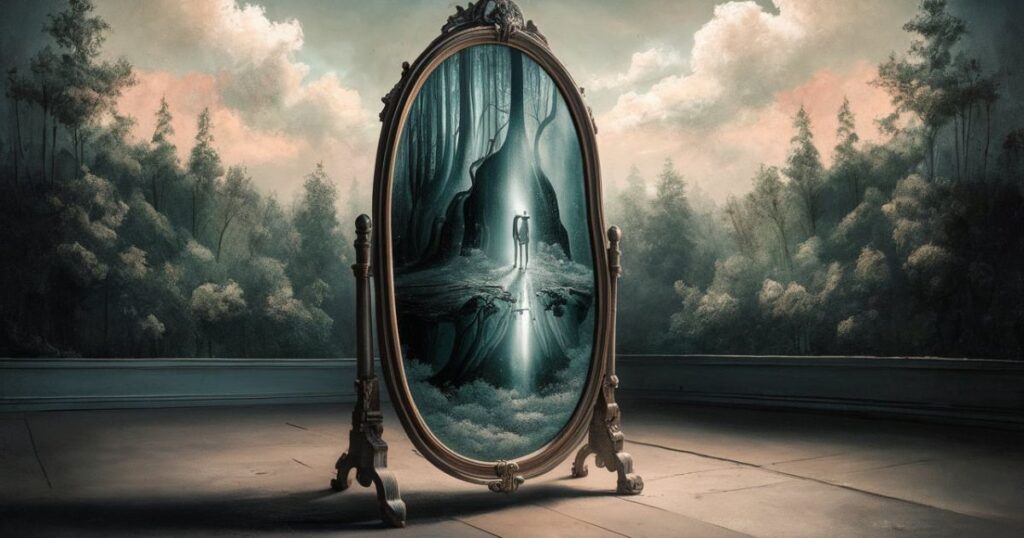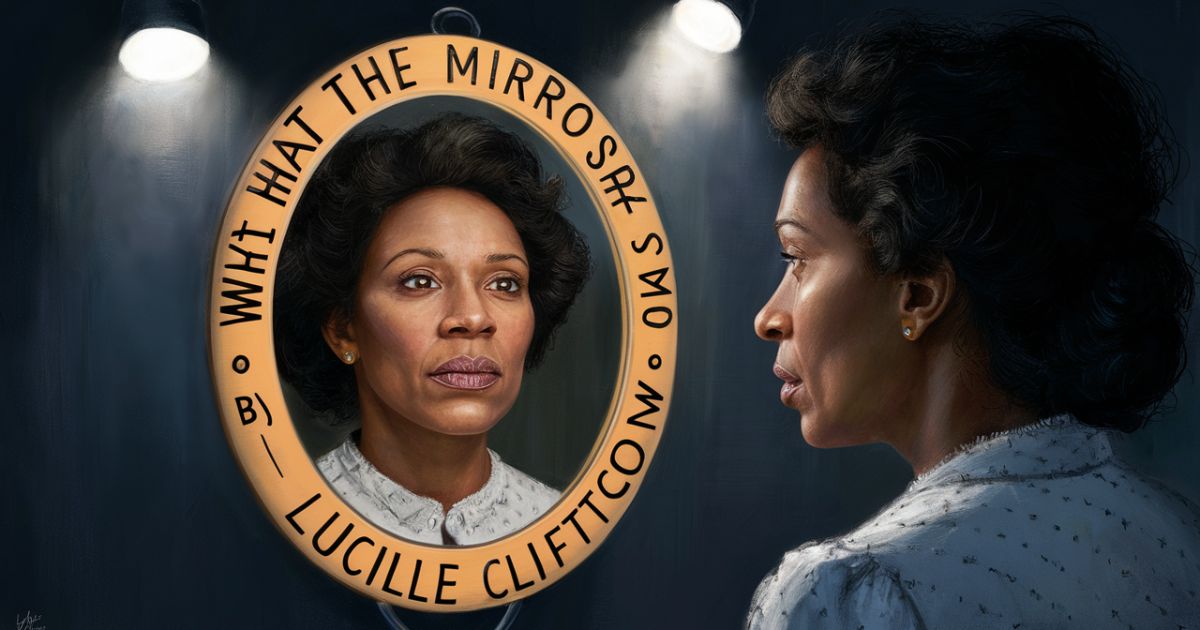Ever gazed into a mirror and wished it could speak back? In her powerful poem “What the Mirror Said,” Lucille Clifton brings this idea to life, crafting a moving dialogue between a woman and her reflection. Let’s dive into this literary masterpiece and uncover the layers of meaning hidden within its lines. What the Mirror Said by Lucille Clifton?
Key Takeaways
Before we plunge deeper, here’s a glance at what makes “What the Mirror Said” so impactful:
- Clifton’s mirror doesn’t just reflect—it speaks, challenging how we see ourselves
- The poem throws conventional beauty standards out the window
- It’s a rallying cry for self-love and acceptance
- Clifton turns the mirror from a source of criticism into a cheerleader
- Readers often find themselves re-evaluating their self-image after encountering this poem
The Power of Vivid Imagery
Clifton doesn’t just write a poem; she paints a picture with words. The mirror in “What the Mirror Said” comes alive, speaking directly to the reader. It’s not your run-of-the-mill looking glass—it’s a wise, affirming presence.
Consider these lines:
“listen,
you a wonder.
you a city
of a woman.”
Here, Clifton transforms the reader from a mere individual into an entire metropolis of womanhood. It’s a striking image that expands our understanding of personal identity.
The poem’s imagery doesn’t stop there. Clifton employs a range of sensory details:
- Visual: “You got a geography of your own”
- Tactile: “Your breath makes fog on the world”
- Auditory: “Listen” (repeated throughout)
This multisensory approach immerses the reader in the experience, making the mirror’s words feel tangible and real. What the Mirror Said by Lucille Clifton?

Challenging Societal Beauty Standards
Clifton’s mirror doesn’t mince words when it comes to conventional beauty ideals. It flat-out rejects them. In a world obsessed with unrealistic standards, “What the Mirror Said” is a breath of fresh air.
The poem tackles beauty norms head-on:
- It celebrates features often criticized (like “big thighs” and “full lips”)
- It redefines beauty on its terms
- It empowers readers to see themselves through a new lens
“don’t you love your self?
you are a wonder.
you are more than enough.”
These lines aren’t just feel-good fluff—they’re a direct challenge to a culture that often tells women they’re not enough.
Embracing True Self
At its core, “What the Mirror Said” is an anthem of self-acceptance. Clifton’s mirror doesn’t just reflect physical features; it reveals the essence of the person gazing into it.
The poem encourages readers to:
- Recognize their inherent worth
- Embrace their unique qualities
- Reject external pressures to conform
- Celebrate their individuality
It’s like having a personal cheerleader in your bathroom mirror, reminding you of your awesomeness every morning. What the Mirror Said by Lucille Clifton?
The Role of Language in Self-Perception
Clifton’s word choice in “What the Mirror Said” isn’t random—it’s a carefully crafted tool for reshaping self-perception. Let’s break it down:
| Word/Phrase | Impact on Self-Perception |
|---|---|
| “Wonder” | Instills a sense of awe and uniqueness |
| “City” | Implies complexity and importance |
| “Listen” | Demands attention and reflection |
| “Enough” | Counters feelings of inadequacy |
The repetition of affirming phrases throughout the poem acts like a mantra, reinforcing positive self-talk. It’s as if Clifton is teaching us a new language of self-love.
The Mirror as a Symbol of Reflection
In “What the Mirror Said,” the mirror isn’t just a piece of reflective glass—it’s a portal to self-discovery. Clifton flips the script on the typical mirror symbolism in literature, which often represents vanity or self-doubt.
Instead, this mirror:
- Serves as a wise counselor
- Encourages deep introspection
- Reveals hidden strengths
- Challenges negative self-perceptions
It’s like having a therapy session every time you brush your teeth!

Breaking Free From External Validation
Clifton’s poem is a declaration of independence from society’s judgments. The mirror’s words urge the reader to stop seeking approval from others and start validating themselves.
Consider this empowering statement:
“you a real good thing”
It’s simple, direct, and powerful. No ifs, ands, or buts about it. You’re good, period. Full stop.
This message resonates in a world where we’re constantly bombarded by ads telling us we need to change. Clifton’s mirror says, “Nope, you’re great as is.”
Self-acceptance and Body Image
In just a few short lines, “What the Mirror Said” delivers a masterclass in body positivity. Clifton doesn’t shy away from specific physical features—she celebrates them.
The poem’s approach to body image:
- Acknowledges physical features often criticized
- Reframes them as sources of beauty and strength
- Encourages readers to see their bodies as unique landscapes
- Promotes a healthy, loving relationship with oneself
It’s like a vaccination against the body-shaming virus that’s all too prevalent in our culture.
Engaging in a Dialogue on Self-Perception
One of the most striking aspects of “What the Mirror Said” is its conversational tone. It’s not a lecture—it’s a dialogue. And by reading it, we’re invited into that conversation.
The poem prompts us to ask ourselves:
- How do I see myself?
- What would my mirror say if it could speak?
- Am I listening to the right voices about my worth?
It’s a starting point for deeper discussions about self-worth, beauty, and identity. In book clubs, classrooms, and living rooms across America, Clifton’s words have sparked countless conversations about how we perceive ourselves and others.
Conclusion: The Lasting Echo of Clifton’s Mirror
“What the Mirror Said” isn’t just a poem—it’s a revolution in 112 words. Lucille Clifton managed to pack a punch of self-love, body positivity, and empowerment into a few short stanzas.
In a world that often tells us we’re not enough, Clifton’s mirror reflects our inherent worth. It challenges us to see ourselves through kinder eyes and to celebrate the unique “geography” of our beings.
So next time you’re standing in front of the mirror, remember Clifton’s words. Let them echo in your mind. And maybe, just maybe, you’ll start to see what that poetic mirror saw—a wonder, a city, a real good thing.
After all, isn’t it time we all learned to love what the mirror said?
FAQs
What is the main theme of “What the Mirror Said” by Lucille Clifton?
The main theme of the poem is self-empowerment and self-acceptance. It emphasizes the importance of recognizing one’s beauty and worth, despite societal pressures and standards.
Who is the speaker in the poem “What the Mirror Said”?
The speaker in the poem is a woman who is conversing with her reflection in the mirror. The mirror serves as a metaphorical voice that encourages her to see her strength and beauty.
What literary devices does Lucille Clifton use in the poem?
Clifton uses personification, giving the mirror a voice to speak directly to the woman. She also employs metaphor and repetition to reinforce the message of self-worth and empowerment.
How does “What the Mirror Said” reflect Lucille Clifton’s style and themes?
The poem reflects Clifton’s style through its simplicity, directness, and emotional depth. Themes of resilience, identity, and self-love are common in her work, and this poem is a powerful example of these elements.
Why is “What the Mirror Said” considered an important poem?
The poem is important because it speaks to universal themes of self-acceptance and the struggle against societal beauty standards. It resonates with many readers, offering a message of encouragement and affirmation.



